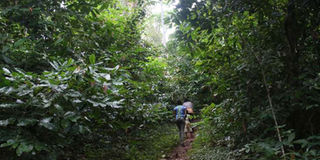Giitune Sacred Forest: Where Meru’s rich culture is preserved

The road leading to Giitune Sacred Forest Heritage Site in Ruiga, Imenti Central, on December 2, 2015. The forest has extremely cold and foggy weather. PHOTO | PHOEBE OKALL | NATION MEDIA GROUP
What you need to know:
- Apart from its thick vegetation and scenic tree canopies, Giitune Forest is home to the sacred colobus monkeys.
- Visitors learn how to prepare traditional meals of the Ameru people and dress in their traditional attire.
Lying on the Equator cutting through Meru at Gatimbi is Giitune Sacred Forest and Equator Cultural Centre.
Located about 10km from Meru Town, the indigenous forest is listed as a national monument and a traditional religious centre.
The forest has extremely cold and foggy weather.
Apart from its thick vegetation and scenic tree canopies, Giitune Forest is home to the sacred colobus monkeys.
It is believed that a curse will befall anybody who kills a sacred colobus monkey in this forest.
The forest has unique plant species such as the giant yellow mulberry, African wild olive and large-leafed cordia.
The forest is also a sacred site.
Ameru elders Njuri Ncheke cleanse people who have been cursed for committing a taboo by performing sacrifices in the forest.
The elders carry out age-old rituals to forestall a misfortune when people who have made mistakes.
The forest is a favourite destination for hikers who arrive in droves to test their endurance by scaling the hills for sheer fun.
The forest is so respected that it is believed that if one cuts a tree, it cries and bleeds.
Voices are heard crying out loud, lamenting that “their child has been injured”.
This automatically invites a curse on the person and his family.
NO-GO ZONE
This belief has been used to educate generations in conserving the forest.
Any sexual acts in the forest were taken as the highest form of sacrilege.
A myth is also held that there was lake protected by a huge snake that blocks the pathway of anyone who trespassed into the forest.
It was a no-go zone since there was also a believed that there existed a deep lake where anyone who trespassed would drown.
A kilometre away from the Giitune Sacred Forest is a cultural centre for the Ameru.
It has the setting of a traditional Ameru household, and tools used during different occasions.
Visitors learn how to prepare traditional meals of the Ameru people and dress in their traditional attire.




